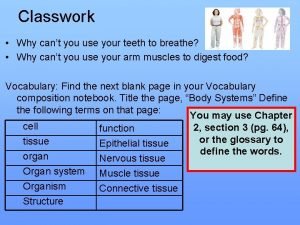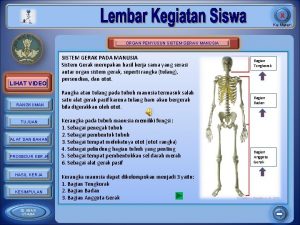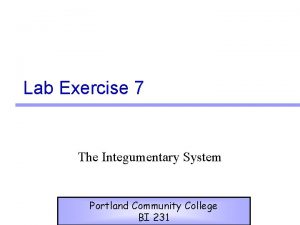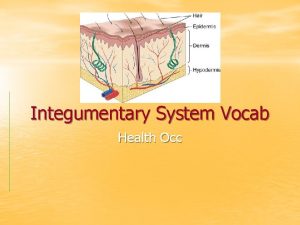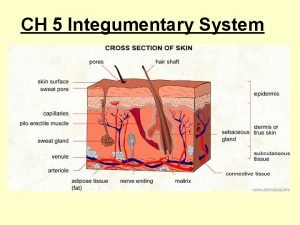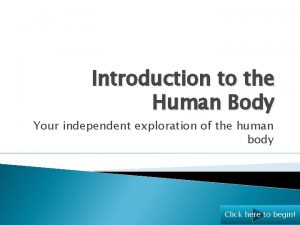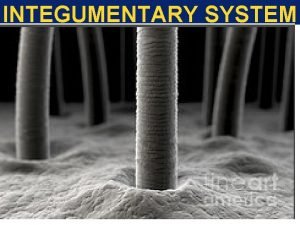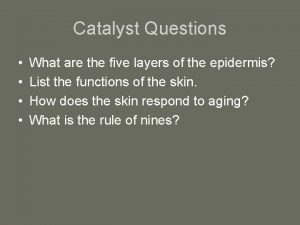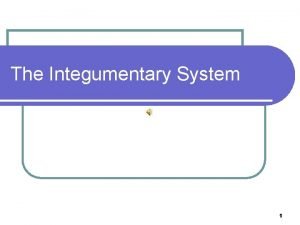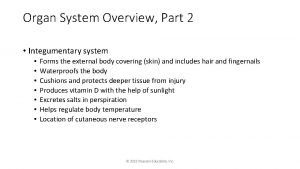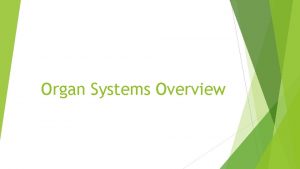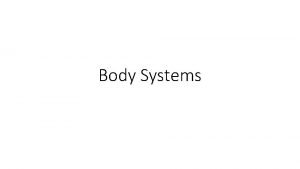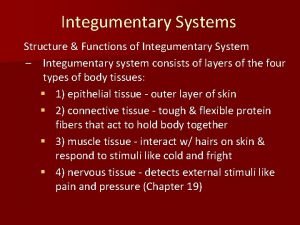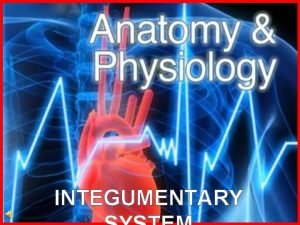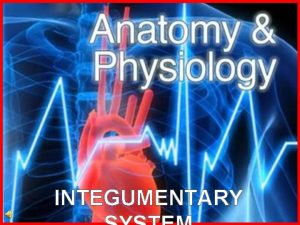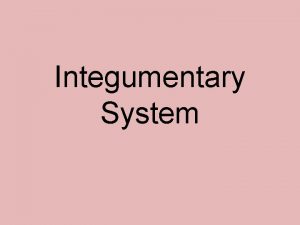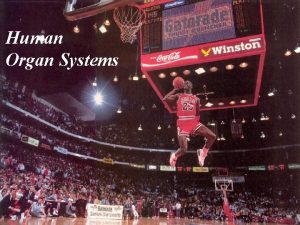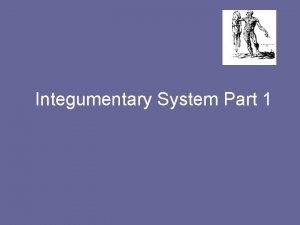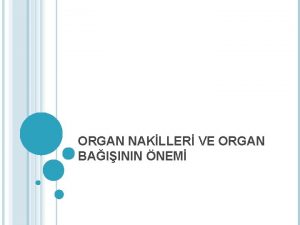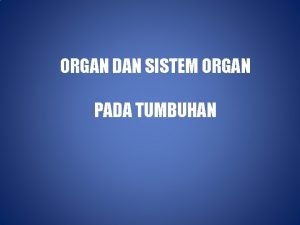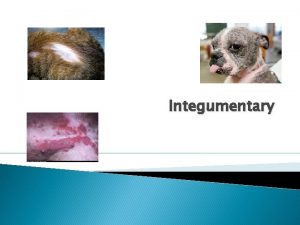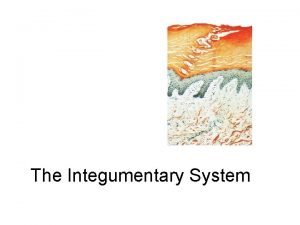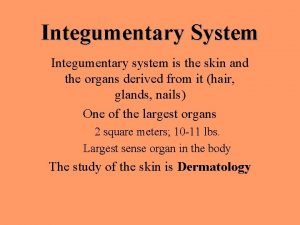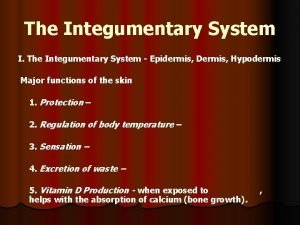Organ System Overview Part 2 Integumentary system Forms























- Slides: 23

Organ System Overview, Part 2 • Integumentary system • • Forms the external body covering (skin) and includes hair and fingernails Waterproofs the body Cushions and protects deeper tissue from injury Produces vitamin D with the help of sunlight Excretes salts in perspiration Helps regulate body temperature Location of cutaneous nerve receptors © 2018 Pearson Education, Inc.

Figure 1. 2 a The body’s organ systems. Hair Skin Fingernails (a) Integumentary System Forms the external body covering; protects deeper tissue from injury; synthesizes vitamin D; location of sensory receptors (pain, pressure, etc. ) and sweat and oil glands. © 2018 Pearson Education, Inc.

Organ System Overview • Skeletal system • • • Consists of bones, cartilages, ligaments, and joints Provides muscle attachment for movement Protects vital organs Site of blood cell formation Stores minerals © 2018 Pearson Education, Inc.

Figure 1. 2 b The body’s organ systems. Cartilages Joint Bones (b) Skeletal System Protects and supports body organs; provides a framework the muscles use to cause movement; blood cells are formed within bones; stores minerals. © 2018 Pearson Education, Inc.

Organ System Overview • Muscular system • Skeletal muscles contract (or shorten) • Produces movement of bones © 2018 Pearson Education, Inc.

Figure 1. 2 c The body’s organ systems. Skeletal muscles (c) Muscular System Allows manipulation of the environment, locomotion, and facial expression; maintains posture; produces heat. © 2018 Pearson Education, Inc.

Organ System Overview • Nervous system • • • Fast-acting control system Consists of brain, spinal cord, nerves, and sensory receptors Responds to internal and external stimuli Sensory receptors detect changes Messages are sent to the central nervous system Central nervous system assesses information and activates effectors (muscles and glands) © 2018 Pearson Education, Inc.

Figure 1. 2 d The body’s organ systems. Brain Sensory receptor Spinal cord Nerves (d) Nervous System Fast-acting control system of the body; responds to internal and external changes by activating appropriate muscles and glands. © 2018 Pearson Education, Inc.

Organ System Overview • Endocrine system • Secretes chemical molecules, called hormones, into the blood • Body functions controlled by hormones include: • Growth • Reproduction • Use of nutrients © 2018 Pearson Education, Inc.

Organ System Overview • Endocrine system (continued) • Endocrine glands include: • • Pituitary gland Thyroid and parathyroids Adrenal glands Thymus Pancreas Pineal gland Ovaries (females) and testes (males) © 2018 Pearson Education, Inc.

Figure 1. 2 e The body’s organ systems. Pineal gland Pituitary gland Thyroid gland (parathyroid glands on posterior aspect) Thymus gland Adrenal glands Pancreas Testis (male) Ovary (female) (e) Endocrine System © 2018 Pearson Education, Inc. Glands secrete hormones that regulate processes such as growth, reproduction, and nutrient use by body cells.

Organ System Overview • Cardiovascular system • Includes heart and blood vessels • Heart pumps blood • Vessels transport blood to tissues • Blood transports: • Oxygen and carbon dioxide • Nutrients • Hormones • Blood also contains white blood cells and chemicals that provide protection from foreign invaders © 2018 Pearson Education, Inc.

Figure 1. 2 f The body’s organ systems. Heart Blood vessels (f) Cardiovascular System Blood vessels transport blood, which carries oxygen, nutrients, hormones, carbon dioxide, wastes, etc. ; the heart pumps blood. © 2018 Pearson Education, Inc.

Organ System Overview • Lymphatic system • Includes lymphatic vessels, lymph nodes, and lymphoid organs • Complements the cardiovascular system by returning leaked fluids back to bloodstream • Lymph nodes and other lymphoid organs cleanse the blood • Houses white blood cells, which are involved in immunity © 2018 Pearson Education, Inc.

Figure 1. 2 g The body’s organ systems. Lymph nodes Lymphatic vessels (g) Lymphatic System Picks up fluid leaked from blood vessels and returns it to blood; disposes of debris in the lymphatic stream; houses white blood cells involved in immunity. © 2018 Pearson Education, Inc.

Organ System Overview • Respiratory system • Includes the nasal passages, pharynx, larynx, trachea, bronchi, and lungs • Gases are exchanged with the blood through air sacs in the lungs • Supplies the body with oxygen • Removes carbon dioxide © 2018 Pearson Education, Inc.

Figure 1. 2 h The body’s organ systems. Nasal cavity Pharynx Larynx Trachea Bronchi Lungs (h) Respiratory System Keeps blood constantly supplied with oxygen and removes carbon dioxide; the gaseous exchanges occur through the walls of the air sacs of the lungs. © 2018 Pearson Education, Inc.

Organ System Overview • Digestive system • Includes the oral cavity (mouth), esophagus, stomach, small and large intestines, rectum, and accessory organs • Breaks down food • Allows for nutrient absorption into blood • Eliminates indigestible material as feces © 2018 Pearson Education, Inc.

Figure 1. 2 i The body’s organ systems. Oral cavity Esophagus Stomach Small intestine Large intestine Rectum (i) Digestive System Breaks food down into absorbable nutrients that enter the blood for distribution to body cells; indigestible foodstuffs are eliminated as feces. © 2018 Pearson Education, Inc.

Organ System Overview • Urinary system • • • Includes the kidneys, ureters, urinary bladder, and urethra Eliminates nitrogenous wastes Maintains acid-base balance Regulates water and electrolyte balance Helps regulate normal blood pressure © 2018 Pearson Education, Inc.

Figure 1. 2 j The body’s organ systems. Kidney Ureter Urinary bladder Urethra (j) Urinary System Eliminates nitrogen-containing wastes from the body; regulates water, electrolyte, and acid-base balance of the blood. © 2018 Pearson Education, Inc.

Organ System Overview • Reproductive system • For males, includes the testes, scrotum, penis, accessory glands, and duct system • Testes produce sperm • Duct system carries sperm to exterior • For females, includes the ovaries, uterine tubes, uterus, and vagina • Ovaries produce eggs • Uterus provides site of development for fetus © 2018 Pearson Education, Inc.

Figure 1. 2 k-l The body’s organ systems. Seminal vesicles Prostate gland Mammary glands (in breasts) Uterine tube Ovary Uterus Penis Testis Scrotum (k) Male Reproductive System Vagina (l) Female Reproductive System Overall function of the reproductive system is production of offspring. Testes produce sperm and male sex hormone; ducts and glands aid in delivery of viable sperm to the female reproductive tract. Ovaries produce eggs and female sex hormones; remaining structures serve as sites for fertilization and development of the fetus. Mammary glands of female breasts produce milk to nourish the newborn. © 2018 Pearson Education, Inc.
 Cell tissue organ organ system organism
Cell tissue organ organ system organism Tissue are grouped together to form various
Tissue are grouped together to form various Organ and organ system
Organ and organ system Organ penyusun sistem gerak pada manusia
Organ penyusun sistem gerak pada manusia Tractus respiratorius
Tractus respiratorius Organ penyusun sistem indra
Organ penyusun sistem indra Epidermis
Epidermis Integumentary system vocabulary
Integumentary system vocabulary Integumentary system of swine
Integumentary system of swine Integument adalah
Integument adalah Integumentary system facts
Integumentary system facts Exercise 7 the integumentary system
Exercise 7 the integumentary system Integumentary system vocab
Integumentary system vocab Exfoliative dermatitis
Exfoliative dermatitis Integumentary system
Integumentary system Integumentary system assessment
Integumentary system assessment Integumentary system analogy
Integumentary system analogy The integumentary system
The integumentary system The integumentary system
The integumentary system Integumentary system components
Integumentary system components Integumentary system effects of aging
Integumentary system effects of aging Section 36-3 the integumentary system
Section 36-3 the integumentary system Integumentary system
Integumentary system Integumentary system
Integumentary system
